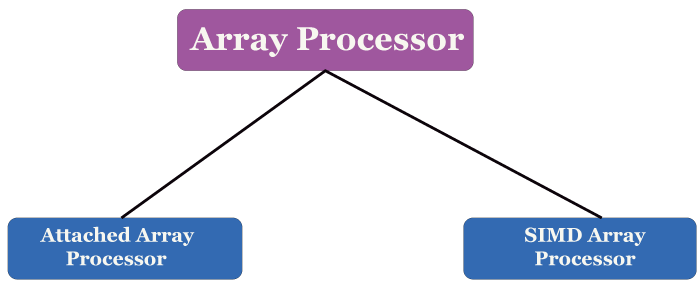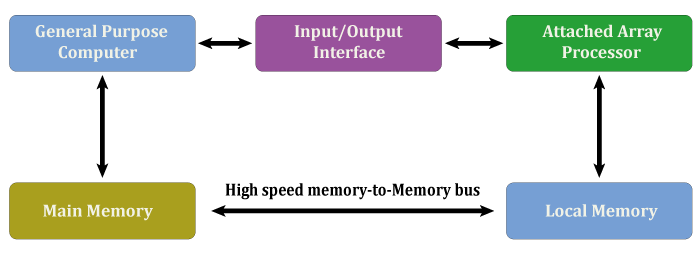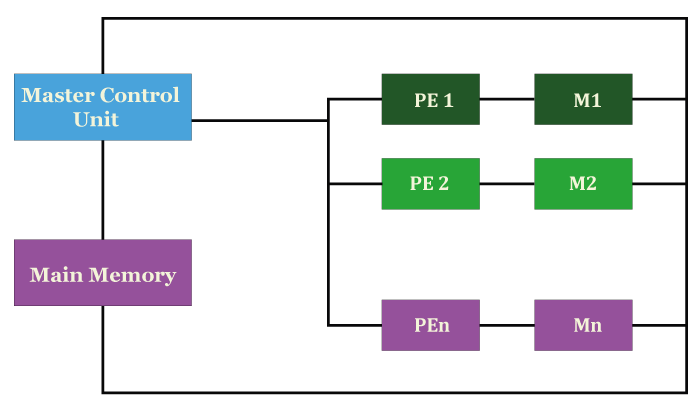Introduction to Array Processor in COA
Unlike traditional processors that operate on scalar values (i.e., single data items), array processors are optimized to handle large amounts of data simultaneously by leveraging parallel processing techniques.
Array processors typically consist of multiple processing elements that work in parallel to perform operations on arrays of data. Each processing element can operate independently and in parallel with other processing elements, allowing for high-performance computing on large datasets.
Classification of Array Processor
Array processors can be classified into two categories: Attached Array Processors and SIMD Array Processors.

1. Attached array processor
Attached Array Processors are auxiliary processors connected to a general-purpose computer to enhance its performance in numerical computational tasks. They use numerous functional units in parallel processing to provide excellent performance. The attached array processor includes a common processor with an input/output interface and a local memory interface, with the main memory and local memory linked together. These processors are intended to improve the performance of the host computer in specific numeric computations.

2. SIMD Array Processors
These are a type of computer with multiple parallel processors designed to work together under the supervision of a single control unit. This results in a single instruction stream and multiple data streams. The processor comprises several identical processing elements (PEs), each with its local memory M, ALU, and registers. The master control unit controls the processing elements' actions, decodes instructions, and determines how they should be carried out. The program is stored in the main memory, and vector instructions are sent to all PEs simultaneously, with the results stored in memory.

SIMD Array Processors can be configured in two ways.
- The first configuration uses RAM (Random Access Memory) and is known as Dedicated Memory Organisation, which includes ILLIAC-IV, CM-2, and MP-1.
- The second configuration uses content-accessible memory and is known as Global Memory Organisation, which includes BSP.
Array processors are designed to enhance the total speed of instruction processing, particularly in repetitive arithmetic operations, making them faster at vector arithmetic than the host CPU. As they run asynchronously from the host CPU, they improve the system's overall capacity. Additionally, array processors have their own local memory, providing additional memory to systems with limited physical memory or address space. This is an essential consideration for systems with limited memory resources.
Applications of Array Processor
- Radar systems: Array processors are used in radar systems to process the large amount of data generated by radar signals. By using an array of sensors, the processor can process the data in parallel to detect and track objects in real-time, making them essential in applications such as air traffic control and military surveillance.
- Sonar systems: Array processors are used in sonar systems to process the large amount of data generated by underwater sound waves. By using an array of sensors, the processor can process the data in parallel to detect and track underwater objects, making them essential in applications such as underwater exploration, navigation, and military operations.
- Seismic communication: Array processors are used in seismic communication systems to process the large amount of data generated by seismic waves. By using an array of sensors, the processor can process the data in parallel to detect and analyze changes in the earth's surface, making them essential in applications such as earthquake detection and exploration of natural resources.
- Medical applications: Array processors are used in medical applications such as CT and MRI scans to process the large amount of data generated by these imaging techniques. By using an array of sensors, the processor can process the data in parallel to generate high-resolution images of the human body, making them essential in medical diagnosis and treatment.
- Anti-jamming: Array processors can be used in communication systems to prevent interference from jamming signals. By using multiple antennas, the array processor can process the received signals in parallel to determine the direction of the desired signal and null out any jamming signals. This technique is known as beamforming and is commonly used in military and commercial communication systems.
- Speed enhancement: Array processors can be used to improve the speed and efficiency of many data-intensive computing tasks, such as image and signal processing, scientific computing, and data analysis. By processing data in parallel, the array processor can significantly reduce the time required to complete these tasks, making them an important tool for high-performance computing.
- Astronomy applications: Array processors are used in astronomy applications to process large amounts of data generated by telescopes and other astronomical instruments. By using an array of sensors, the processor can process the data in parallel to detect and analyze celestial objects, such as stars, galaxies, and black holes. Array processors are used in many modern observatories, such as the Atacama Large Millimeter Array (ALMA) in Chile and the Square Kilometer Array (SKA) radio telescope.